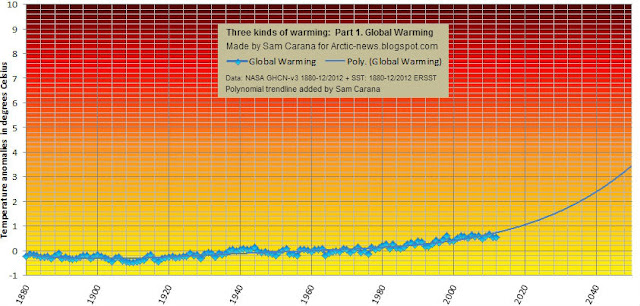Let's go back in time. This is from a post written ten years ago:
We may suddenly face a future in which many if not most people will have little or no access to food, water, medicines, electricity and shelter, while diseases go rampant and gangs and warlords loot and devastate the few livable areas left. Human beings as a species will face the risk of total extinction, particularly if many species of animals and plants that humans depend on will disappear. The post continues: Many people are still in denial about the severity of the problem of global warming, the accumulation of dangers and their progression.
Indeed, even today many people will still deny that such events could strike suddenly, e.g. within a few years time. Many people use linear trends to predict the future many years from now. As an example, the straight blue line on the graph below is a linear trend based on NASA 1880-current meteorological stations data. The problem is that linear trends, especially when based on data that go back many years, can make people overlook important recent changes such as the temperature rise that has taken place over the past few years, the decline of glaciers and sea ice and the recent increases in concentrations of carbon dioxide in the atmosphere.
 |
| [ click on image to enlarge ] |
The appropriateness of linear versus non-linear trends was also discussed earlier at the Controversy page.
In addition to looking at trends that are contained in such data, it makes sense to analyse the different elements contributing to such a rise. Such elements are discussed in more detail at the extinction page, which confirms the potential for a 10°C temperature rise within years, i.e. by the year 2026.
The situation is dire and calls for comprehensive and effective action as described in the Climate Plan.
Links
• Climate Plan
http://arctic-news.blogspot.com/p/climateplan.html
• Ten Dangers of Global Warming
http://arctic-news.blogspot.com/p/ten-dangers-of-global-warming.html
• Extinction
http://arctic-news.blogspot.com/p/extinction.html
• Controversy
http://arctic-news.blogspot.com/p/controversy.html
• Warning of mass extinction of species, including humans, within one decade
http://arctic-news.blogspot.com/2017/02/warning-of-mass-extinction-of-species-including-humans-within-one-decade.html










